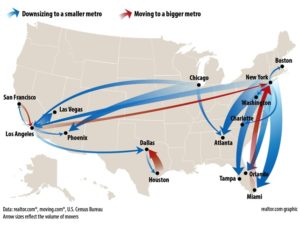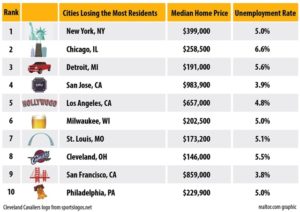Whether for professional or personal reasons, people sometimes pick up and move. In the United States, folks have been migrating to urban areas in recent generations, but these days the places they wind up are not necessarily the major hubs we might expect.
Recently, real estate information platform, Realtor.com, completed a study on where people are moving to—and where they are moving away from. The results are not surprising to anyone who has paid attention to where jobs and new companies are being generated.
The number one city people are moving to, Realtor.com found, is Tampa. Florida itself is home to three of the cities on the top-10 list and it’s popular for migrating Americans because the state has no income tax, it has yet to fully bounce back from the housing crash of 2008-2009 so home prices are still relatively low, and there is strong job creation there.
Florida is also experiencing a decline in foreign buyers. According to Realtor.com, that means that there are more homes on the market which makes prices slower to rise and there is more product for incoming residents.
Another land where job creation is drawing new people in is Texas. New companies, tech development and jobs put San Antonio and Austin on the list.
Also in the top-10 is Raleigh and Charlotte, North Carolina, which have received a lot of attention as a job-creating engine on the east coast, says Realtor.com chief economist, Jonathan Smoke. “People are probably used to hearing about Austin, Texas; Denver, Colorado; San Francisco and San Jose, for example–they are the east-coast flavor of that,” he said. “In particular Raleigh, because of the research triangle area, there’s quite a bit of high tech job creation and job growth there. But a lot of young people are coming out of universities in or near those cities. Enjoying the quality of life, and seeing the job opportunities.” When they stay, housing costs are lower than southern or west coast cities where tech is on the rise.
Realtor.com also tracked the cities that residents are leaving. A group that includes some of the more established urban areas in the country.
Smoke is careful to point out that the cities on the above graph are not losing population and shrinking, but folks have been leaving over the past several years, especially in the northeast and Midwest. But they are not shrinking and many have significant international immigration.
“The bottom of the list, I think, tends to be a big mixture,” says Smoke. “You’ve got older, extremely large cities like Chicago and New York that are always going to have people considering if the grass is greener in other places. And then you’ve got places that are so expensive – like San Francisco, San Jose, Los Angeles in particular, and New York – so some of it is affordability.”
In putting together its report, Realtor.com used the most recent data from its own database, recent data from another site it owns, Moving.com, as well as numbers from Census Bureau migration data collected from 2009 to 2013 that tracked people’s moves in and out of metropolitan areas.
Source: Forbes Online, Karsten Strauss. Jun 7, 2016




